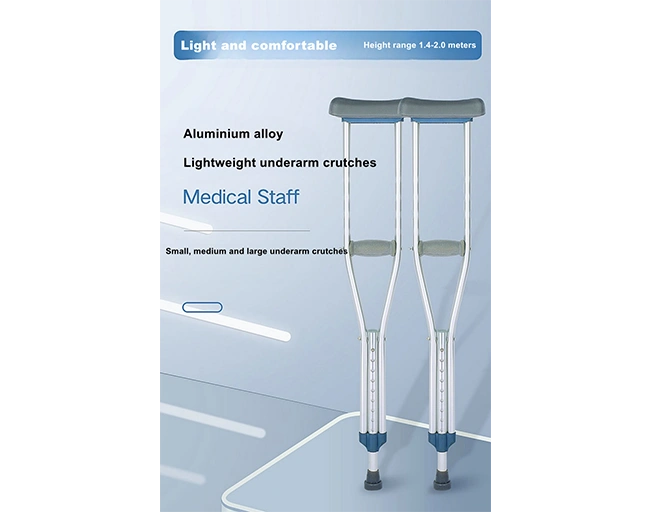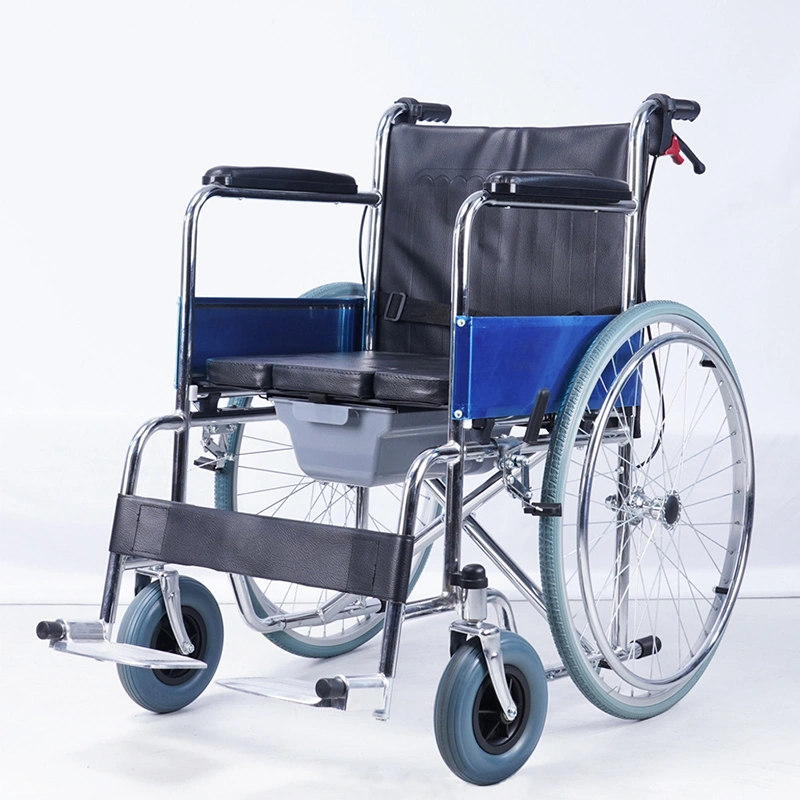When Should You Shop Crutches? Expert Insights on Mobility Aids
Time : Nov 06, 2025 View : 323
béquilles act as key helpers for people getting better from hurts, operations, or handling ongoing health issues. Knowing the right time to buy crutches can greatly affect healing speed, ease, and freedom. This piece looks at main clues that show the need for crutches, kinds you can find, and ways to pick the best pair for your case.

Signs That Indicate You May Need Crutches
Figuring out when you need help to move is vital for staying safe and helping healing go well. Many health problems and events call for crutches as extra walking tools.
Common Injuries Requiring Crutch Use
Ankle twists or breaks that stop you from putting weight on the foot often need crutch help. This stops more harm and lets healing happen right. These hurts can mess up balance and steadiness a lot. Walking without help feels painful and risky.
Knee hurts like torn ligaments or after-surgery healing often need short-term moving support. This includes ACL fixes, meniscus work, or other knee jobs. Crutches shift weight off the mending joint. Yet, they keep some movement and self-reliance.
Hip or thigh bone breaks that demand no weight on the hurt leg stand as some of the worst cases. They need full avoidance of pressure on the bad limb. So, crutches become a must for safe steps during healing time.
Chronic Conditions That Benefit from Crutch Support
Arthritis that brings joint wobble or ache when walking can gain a lot from crutch aid. The extra hold cuts down force on sore joints. It also gives steadiness while moving. Thus, people keep their ability to get around despite long-lasting pain.
Nerve problems that hit balance and control often need constant moving help. Issues like multiple sclerosis, Parkinson’s, or getting better from a stroke can hurt body sense and movement skills. Crutches turn into useful items. They help keep freedom and stop falls.
Muscle-wasting sickness or other fading illnesses slowly weaken muscles. This makes walking alone harder over time. Crutches can make up for weak muscles. And they let folks join in daily tasks and friend meet-ups.
Post-Surgical Recovery Considerations
Operations on lower legs often call for short-term moving help. This guards surgery spots and aids good healing. Bone surgeries, especially, need limited weight times. Here, crutches grow necessary for safe steps.
Doctors may suggest crutches to ease force on mending parts. This lets the body’s fix systems work well without full weight stress. Such a careful way can boost surgery results a lot. And it lowers the chance of troubles.
Types of Crutches and Their Applications
Learning about the various kinds of crutches helps you choose the best one for your own needs and events.
Axillary (Underarm) Crutches
Good for brief use during hurt recovery, axillary crutches are the most known type of moving aid. These have soft tops that sit under the arms. Hand holds sit lower for more help and control.
They give strong backing. But they might cause underarm ache with long use. So, they fit best for short cases like after-surgery or sudden hurt care. The build allows great steadiness. Yet, it needs right fit to stop nerve harm or blood flow problems.
Forearm (Lofstrand) Crutches
Perfect for lasting use and better moving control, forearm crutches give top skill in handling and less tiredness over long times. These have rings that go around the lower arms. They provide steadiness. And they allow more natural arm swings.
They let better arm motion and cut shoulder stress. This makes them great for folks who need forever or long help with moving. The comfy build spreads weight better. It also helps users keep good posture when using.
Platform Crutches
Made for users with weak hand power or grip troubles, platform crutches fit people with arthritis, carpal tunnel, or other hand function issues. The special build has flat surfaces that hold the lower arms.
Arms rest on a flat surface. Lower arm straps add more steadiness. This lets weight go through the lower arms, not the hands. Such a build helps a lot for users who can’t hold normal crutch handles well.

How to Choose the Right Crutches for Your Needs
Picking the proper crutches needs careful thought of many points. These affect both ease and safety when using.
Factors to Consider Before You Shop Crutches
Length of use: short-term versus long-term help needs shape the crutch kind that gives best ease and work. Short users may find axillary crutches enough. But long users usually gain from forearm or platform kinds.
Body strength and control levels of the user decide which crutch gives right help without too much strain. Users with upper body power limits may need platform crutches. Those with good control can use forearm types well.
Ground and places where crutches will be used often change picks of right parts and extras. Inside use on smooth floors differs from outside on bumpy ground. This sways choices about tip kinds and extra steady parts.
Proper Fit and Adjustment Guidelines
Make sure height change is right. This stops posture problems or strain hurts. Follow set fitting rules. Good height stops extra move patterns. These can lead to second hurts in the back, shoulders, or good leg.
Hand holds should line up with wrist height when arms hang loose at sides. This ensures best body position when using. Such line-up helps use energy well. And it cuts tiredness during long walks.
Materials and Weight Capacity Options
Aluminum crutches: light and rust-proof for daily use give a fine mix of strength and easy carry. The light weight cuts user tiredness. Yet it keeps enough power for trusty help in normal tasks.
Steel crutches: heavier but give higher weight limit for bigger users fit folks who go over aluminum model limits. Though heavier, steel build gives top strength and steadiness for users needing max support power.
Where to Shop Crutches and What to Look For in a Supplier
Finding a trusty seller makes sure you get good items that meet safety rules. And they give proper help for your healing needs.
Key Qualities of a Reliable Mobility Aid Supplier
Gives a variety of approved medical-level items that meet set safety and quality rules. Medical-level approval means items go through hard tests. They follow health field needs for patient safety.
Gives clear size guides and buyer help services. These aid buyers pick right items. And they fix any problems during use. Full help services show a seller’s care for buyer joy and item success.
Has warranty choices and return rules. These guard buyers from bad items. And they make sure joy with buys. Strong warranty shows maker trust in item quality. It gives calm for users.
Introducing Xunyu Medical as a Trusted Supplier of Mobility Aids
Xunyu Médical is a solid giver of top-quality moving answers. This includes bedside handrails, crutches, fauteuils roulants, bath chairs, and walking aids. Foshan Xunyu Medical Technology Co., Ltd. is in Danzao Town, Nanhai District, Foshan. It is known for tough stuff and comfy builds. Xunyu Medical helps patients stay on their own. It does this through smart-made items that fit varied rehab needs.
Since it started, Xunyu Medical has put tech newness first. It improves item builds to meet real needs of older groups. Its focus on use and easy traits has won trust from buyers around the world. Now, the company’s items go to Europe, North America, the Middle East, and the Asia-Pacific area. They supply big online sites and health sellers.

Conclusion
Picking the best time to shop crutches means checking your body state, moving limits, and healing aims. Whether you handle a quick hurt or ongoing issue, choosing right crutch kinds and making sure good fit can boost ease and safety a lot. Working with known sellers like Xunyu Medical makes sure you get trusty support tools made for your needs.
Questions fréquentes
Q1: What’s the difference between axillary and forearm crutches?
A: Axillary crutches go under the arms. And they are usually for short hurts. Forearm crutches are held by hands with rings around lower arms. They give better control for lasting use. Axillary ones give max steadiness. But they can cause ache with long use. Forearm ones allow more free motion. And they cut upper body tiredness.
Q2: How do I know if my crutches are adjusted correctly?
A: When you stand straight with arms loose at sides, hand holds should be at wrist height. There should be a 1–2 inch space between your armpit and crutch top. Good change ensures best weight spread. And it stops nerve squeeze or blood flow issues from wrong spot.
Q3: Can I buy crutches online without a prescription?
A: Yes, most shops let you shop crutches without a doctor note. But talking to a health worker is a good idea. This makes sure you pick the right kind for your issue. Expert tips help find the best crutch type, right size, and use steps for your health case and healing plan.


